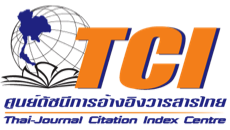การพัฒนาความสามารถในการอ่านเชิงรุกและความพึงพอใจของนักเรียนชั้นมัธยมศึกษาปีที่ 6 ตามแนวคิดการจัดการเรียนรู้แบบบูรณาการเนื้อหาและภาษา (The Development of Active Reading Ability and Satisfaction Based on Content and Language Integrated Learning Approach)
คำสำคัญ:
การพัฒนาความสามารถการอ่านเชิงรุก, ความพึงพอใจ, การจัดการเรียนรู้แบบบูรณาการเนื้อหาและภาษาบทคัดย่อ
การวิจัยครั้งนี้มีจุดมุ่งหมายเพื่อศึกษาผลการพัฒนาความสามารถในการอ่านเชิงรุก และศึกษาความ พึงพอใจของนักเรียนที่ได้รับการจัดการเรียนรู้ตามแนวคิดการบูรณาการเนื้อหา และภาษาของนักเรียนชั้นมัธยมศึกษาปีที่ 6 กลุ่มตัวอย่างที่ใช้ในการศึกษาครั้งนี้ คือ นักเรียนชั้นมัธยมศึกษาปีที่ 6 ภาคเรียนที่ 2 ปีการศึกษา 2562 โรงเรียนสารวิทยา แขวงเสนานิคม เขตจตุจักร กรุงเทพมหานคร ซึ่งได้จากการเลือกแบบเจาะจง จากนั้นทำการสุ่มเลือกนักเรียนแบบแบ่งกลุ่ม และได้กลุ่มตัวอย่างเป็นนักเรียนแผนการเรียน ศิลป์-คำนวณ จำนวน 36 คน ใช้เวลาในการทดลอง 18 คาบเรียน รวม 8 สัปดาห์ เครื่องมือที่ใช้ในการศึกษาครั้งนี้ ได้แก่ แผนการจัดการเรียนรู้การอ่านเชิงรุกตามแนวคิดการจัดการเรียนรู้แบบบูรณาการเนื้อหาและภาษาแบบทดสอบวัดความสามารถในการอ่านเชิงรุกวิชาภาษาอังกฤษ แบบสอบถามความพึงพอใจของนักเรียนต่อการจัดการเรียนรู้ตามแนวคิดการบูรณาการเนื้อหา และภาษา ผลการศึกษาพบว่า นักเรียนชั้นมัธยมศึกษาปีที่ 6 ที่ได้รับการพัฒนาความสามารถในการอ่านเชิงรุกตามแนวคิดการจัดการเรียนรู้แบบบูรณาการเนื้อหา และภาษามีคะแนนหลังเรียนสูงกว่าก่อนเรียนอย่างมีนัยสำคัญทางสถิติที่ระดับ .05 และความพึงพอใจของนักเรียนต่อการจัดการเรียนรู้ตามแนวคิดการบูรณาการเนื้อหา และภาษาอยู่ในระดับมากที่สุด มีค่าเฉลี่ยเท่ากับ 4.58
เอกสารอ้างอิง
CLIL on L2 English Learners’ Oral Production Skills. [Online]. Retrieved July 3, 2018,
from
https://www.recercat.cat/bitstream/handle/2072/169743/Treball%20de%20recerca.pdf?sequence=1
Bruton, A. and Broca, A. (1993). Active Reading. Hong Kong: Thomas Nelson and Sons.
Coyle, D., Hood, P. And Marsh, D. (2010). CLIL: content and language integrated
learning. Cambridge: the University Press, Cambridge.
Hamidavi, N., Amiz, M. S. and Gorjian, B. (2016). “The Effect of CLIL Method on Teaching
Reading Comprehension to Junior High School Students”. Bulletin de la Societe Royale
des Sciences de Liege. (85). Retrieved July 2, 2018, from
https://popups.uliege.be/00379565/index.php?id=6361&file=1
Intapat, C. (2016). “Using Content and Language Integrated Learning (CLIL) in Teaching How
to Cook in English”. The Far Eastern University academic journals 10(4): 7-17. [Online].
Retrieved March 28, 2018, from journal.feu.ac.th/pdf/v10i4.pdf
Koort, K. (2018). Implementing CLIL with Young Learners in Primary School: Creating,
Conducting and Evaluating a Science-English CLIL Project. [Online]. Retrieved July 2,
2018, from http://dspace.ut.ee/handle/10062/60450
Munsegvit, S. (2005). Reading research techniques. 4th ed. Bangkok: Kasetsart University.
Office of the Basic Education Commission. (2018). Guideline for teaching in 21st Century.
[Online]. Retrieved July 10, 2018, from
https://webs.rmutl.ac.th/assets/upload/files/2016/09/20160908101755_51855.pdf
Ortiz, C. C. (2014). The Impact of Adopting a CLIL Approach on EFL Learners Reading Skills in
a Catalonian School. [Online]. Retrieved July 2, 2018, from
http://repositori.uvic.cat/bitstream/handle/10854/3350/trealu_a2014_camara_carolina_impact_adopting_clil.pdf?sequence=1&isAllowed=y
Pakdeejit, Y. (2014). Active Learning and Learning in 21st Century. [Online]. Retrieved July 26,
2018, from apr.nsru.ac.th/Act_learn/myfile/27022015155130_article.doc
Prasongporn, P. (2014). “A Strengthening of Teachers’ Competency in English Teaching Based
on Content and Language Integrated Laerning Approach (CLIL)”. Journal of Education
37(3): 81-88. [Online]. Retrieved June 21, 2018, from http://ednet.kku.ac.th/edujournal/
Sawekngam, W. (2016). Active Learning. [Online]. Retrieved July 26, 2018, from
http://fs.libarts.psu.ac.th/webcontent/KM/01%20KM-Active%20Learning.pdf
Sulistova, Jindriska. (2013). “The Content and Language Integrated Learning Approach in
Use”. Acta Technological Dubnicae. 3(2). [Online]. Retrieved March 28, 2018, from
https://content.sciendo.com/view/journals/atd/3/2/article-p47.xml
Suwannoppharat, K. (2017). “English Language Teaching and Sustainable Development :
Paradox of Convergence”. Inthaninthaksin Journal 12(3): 141-159. [Online]. Retrieved
August 4, 2018, from http://www.huso.tsu.ac.th/huso_mag/journal/1203/120307dt.pd
Tangmomgkollert, S. (2007). “Active Reading”. The Institute for the Promotion of Teaching
Science and Technology 35(148): 61-63. [Online]. Retrieved July 20, 2018, from
http://dl.kids- d.org/bitstream/handle/123456789/HASH7d058e7a0d1e463600c9b4/doc.pdf?sequence=1
Taweerat, P. (1997). Research Methodology in Behavioral and Social Science. 7th ed. Bangkok:
Educational and Psychological Test Bureau, Srinakharinwirot University.
The Open university. (2018). Active Reading. [Online]. Retrieved August 1, 2018, from
http://www2.open.ac.uk/students/skillsforstudy/active-reading.php
Williams, Eddie. (1994). Reading in the Language Classroom. London: Mcmillan Publisher
Ltd.





